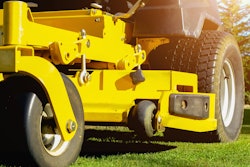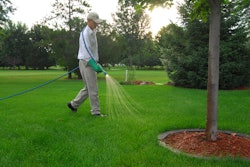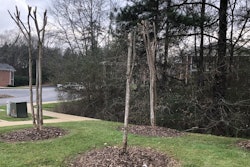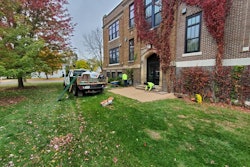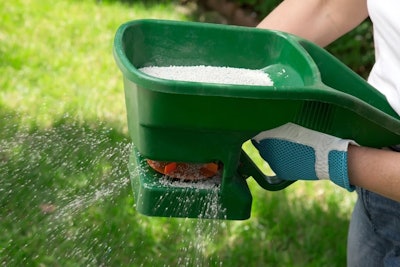
Healthy, green grass convinces customers that professional lawn care is well worth paying for. Fertilizers support turf growth and build up nutrient reserves, making them a key ingredient in maintaining a thriving lawn. A well-fed lawn develops better root systems that can handle heat, cold and drought, along with other stressors such as high foot traffic and mowing.
Getting the fertilization process right results in a beautiful lawn, but when fertilizers are applied incorrectly or at the wrong time, they can encourage weed growth, burn or even kill the grass. That’s why determining when, what and how to apply is as important as choosing the right product for the turf.
Pinpointing when growing zones reach their optimal application window
Early spring is an ideal time to fertilize a lawn in many areas of the country because soil temperatures warm up and grass roots are actively growing after winter dormancy, says Nate Moses, CEO of Precision Landscape Management in Greenville, South Carolina.
“Depending on the region you're in, spring is when the ground and air temperatures allow plants to really uptake nutrients,” says Moses, whose team primarily treats both warm-season Bermuda and zoysia and cool-season fescue. “Start with understanding some of the common attributes about your region, and from there, you can build a program that addresses the majority of your customers’ needs.”
Justin Brown, lawn care program coordinator for Waynes in Birmingham, Alabama, says his crews service two locations with cool-season turf in Huntsville and Nashville, with warm-season turf everywhere else. 
“Because we still have the risk of a light breeze, we don't want to push a ton of growth at that time on our warm-season turf; we do just enough to help it wake back up and get going,” says Brown. “On our cool-season turf, we're a little more aggressive, because we're trying to get it prepped to withstand the summer heat.”
For Chris Denise, applications manager for Franz Witte Landscape in Boise, Idaho, spring fertilizer programs begin closer to early April.
“Our first application usually has a crabgrass control mixed in and we try to put it down as early as we can – before crabgrass starts to germinate as the soil temperatures rise, but not so early that pre-emerging is wearing off while the crabgrass germination is still occurring,” explains Denise, who handles a mix of cool- and warm-season grasses. “We try to have the fertilizers down as close to that window as possible without extending beyond it.”
The secret under the soil
Understanding soil characteristics will also improve fertilization program outcomes, says Toby Mancini, Franz Witte’s operations manager.
“While we don't necessarily do a soil test, there are some consistent generalities of our region,” explains Mancini. “For example, we have a high clay content and low rainfall on an annual basis, which tends to result in a higher alkaline soil that ties up some nutrients. So, one of the other components to our turf fertilization requirements is that we have a readily accessible amount of iron in conjunction with nitrogen. Those are the two most important elements we need for healthy turf in our area.”
While it’s a good practice to test your clients’ soil so you can provide the most comprehensive and prescriptive treatment program, it’s not always possible, adds Moses.
“I believe you should be charging for your time and expertise, and sometimes clients don't want to pay for a soil test,” he says. “In those cases, you just have to communicate that you're going to do what's best based on what you know about the region.”
Brown notes that since most of the soils in his region aren’t typically low in phosphorus and potassium, his team usually won’t test unless they see signs of deficiency.
Choosing the right type of fertilizer for accuracy and coverage
Deciding between liquid and granular products involves analyzing several factors including weather, says Denise.
“Around here, we’ve done some limited liquid fertilizer applications, but a real restricting factor is wind speed,” he notes. “Wind gets excessive, especially in the spring, and that can wreak havoc on a fertilizer location when you're having to constantly stop due to weather conditions.”
Using mostly granular fertilizers gives Denise’s crew more flexibility for when they can apply the product, because it’s more resilient and less prone to weather-related issues.
“Everything we use is a slow-release, because we're built around an eight-week rotation,” he adds. “We have to maximize the longevity of each application to make sure it stays green until we can get back.”
Most of Moses’ programs consist of a heavier liquid application, because his teams can incorporate more elements during one visit than a single granular application could offer.
“In some cases, we're putting down three to five different products per application so we can get some of the micronutrients, iron and additional types of plant care products into the same application without having to go over the lawn three or four times,” says Moses.
Brown uses a mix of slow- and quick-release products in early spring, including a liquid fertilizer on warm-season turf at a very low rate and the last part of their liquid spring pre-emergent.
“We don't want to have to double up on our applications, and we can put everything in at once while we use liquid,” he says. “But on our cool-season turf, it depends on what round we're on, whether we're doing granular application, and weather conditions. Cold weather will kind of force our hand on doing granular instead of liquid.”
Check back tomorrow for part 2 of this series, where we’ll find out what mistakes to avoid when applying fertilizer in early spring.

